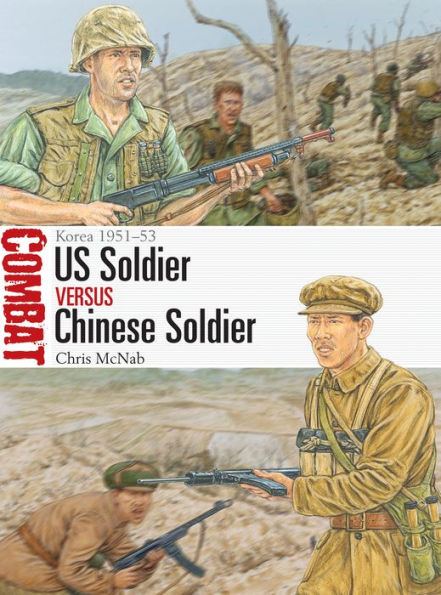This book examines the US infantry against the Chinese Army amid the unforgiving terrain of Korea during the first real clash of the Cold War.
On June 25, 1950, North Korean troops invaded South Korea, triggering a bitter conflict that drew in US and other United Nations forces in support of the South, and soon prompted the Chinese to intervene on the side of the North. Featuring specially commissioned artwork, this study assesses the US and Chinese forces that clashed at Chipyongni (February 13–15, 1951), Triangle Hill (October 14–25, 1952), and Pork Chop Hill (July 6–11, 1953), casting light on the origins, doctrine, and combat effectiveness of these two very different forces during the struggle for victory in Korea.
The Chinese forces fighting in Korea were composed of experienced, confident soldiers buoyed by the Communists' success in the recent Chinese Civil War. Initially armed and equipped with much the same weaponry and doctrine that they had employed in World War II, US Army units in Korea would often find themselves outnumbered, fighting in extremely difficult terrain that precluded the widespread use of armor. Both sides would be tested to the limit by the demands of fighting in such a formidable setting.
1140388421
On June 25, 1950, North Korean troops invaded South Korea, triggering a bitter conflict that drew in US and other United Nations forces in support of the South, and soon prompted the Chinese to intervene on the side of the North. Featuring specially commissioned artwork, this study assesses the US and Chinese forces that clashed at Chipyongni (February 13–15, 1951), Triangle Hill (October 14–25, 1952), and Pork Chop Hill (July 6–11, 1953), casting light on the origins, doctrine, and combat effectiveness of these two very different forces during the struggle for victory in Korea.
The Chinese forces fighting in Korea were composed of experienced, confident soldiers buoyed by the Communists' success in the recent Chinese Civil War. Initially armed and equipped with much the same weaponry and doctrine that they had employed in World War II, US Army units in Korea would often find themselves outnumbered, fighting in extremely difficult terrain that precluded the widespread use of armor. Both sides would be tested to the limit by the demands of fighting in such a formidable setting.
US Soldier vs Chinese Soldier: Korea 1951-53
This book examines the US infantry against the Chinese Army amid the unforgiving terrain of Korea during the first real clash of the Cold War.
On June 25, 1950, North Korean troops invaded South Korea, triggering a bitter conflict that drew in US and other United Nations forces in support of the South, and soon prompted the Chinese to intervene on the side of the North. Featuring specially commissioned artwork, this study assesses the US and Chinese forces that clashed at Chipyongni (February 13–15, 1951), Triangle Hill (October 14–25, 1952), and Pork Chop Hill (July 6–11, 1953), casting light on the origins, doctrine, and combat effectiveness of these two very different forces during the struggle for victory in Korea.
The Chinese forces fighting in Korea were composed of experienced, confident soldiers buoyed by the Communists' success in the recent Chinese Civil War. Initially armed and equipped with much the same weaponry and doctrine that they had employed in World War II, US Army units in Korea would often find themselves outnumbered, fighting in extremely difficult terrain that precluded the widespread use of armor. Both sides would be tested to the limit by the demands of fighting in such a formidable setting.
On June 25, 1950, North Korean troops invaded South Korea, triggering a bitter conflict that drew in US and other United Nations forces in support of the South, and soon prompted the Chinese to intervene on the side of the North. Featuring specially commissioned artwork, this study assesses the US and Chinese forces that clashed at Chipyongni (February 13–15, 1951), Triangle Hill (October 14–25, 1952), and Pork Chop Hill (July 6–11, 1953), casting light on the origins, doctrine, and combat effectiveness of these two very different forces during the struggle for victory in Korea.
The Chinese forces fighting in Korea were composed of experienced, confident soldiers buoyed by the Communists' success in the recent Chinese Civil War. Initially armed and equipped with much the same weaponry and doctrine that they had employed in World War II, US Army units in Korea would often find themselves outnumbered, fighting in extremely difficult terrain that precluded the widespread use of armor. Both sides would be tested to the limit by the demands of fighting in such a formidable setting.
13.49
In Stock
5
1

US Soldier vs Chinese Soldier: Korea 1951-53
80
US Soldier vs Chinese Soldier: Korea 1951-53
80eBook
$13.49
$17.60
Save 23%
Current price is $13.49, Original price is $17.6. You Save 23%.
Related collections and offers
13.49
In Stock

Product Details
| ISBN-13: | 9781472845337 |
|---|---|
| Publisher: | Bloomsbury Publishing |
| Publication date: | 12/22/2022 |
| Series: | Combat , #59 |
| Sold by: | Barnes & Noble |
| Format: | eBook |
| Pages: | 80 |
| File size: | 17 MB |
| Note: | This product may take a few minutes to download. |
About the Author
From the B&N Reads Blog
